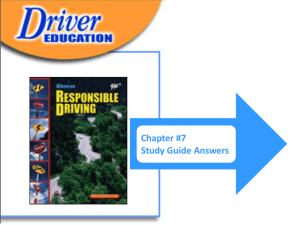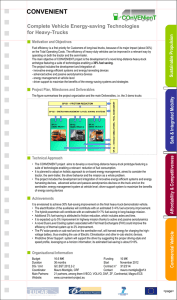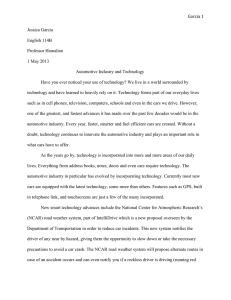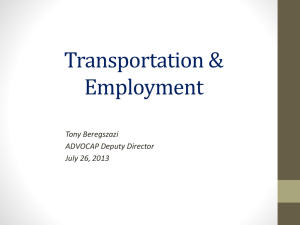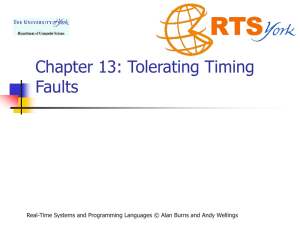real time system and adaptive cruise control
advertisement
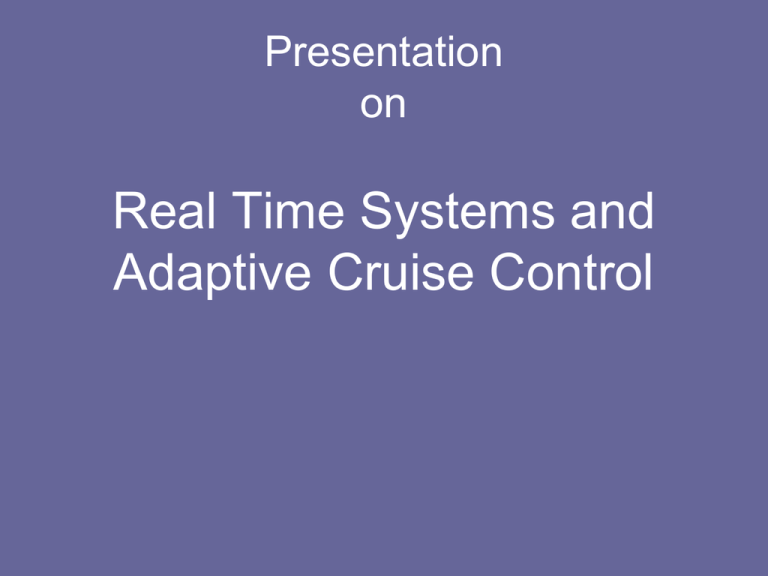
Presentation on Real Time Systems and Adaptive Cruise Control Roadmap • • • • • • • • Introduction to RTS Problem Definition / Motivation Adaptive Cruise Control (ACC) Driver Models Functional Model & Task Model Extensions to Functional Model Conclusion & Future Work References Functional Design & Mapping F2 F1 F5 Functional Design Source: Ian Phillips, ARM F4 VSIA 2001 F3 Architectural Design HW1 Threa d (F2) (F5) (F3) (F4) HW2 HW3 HW4 RTOS/Drivers Hardware Interface What is “real” about real-time? computer world e.g., PC average response for user Interactive occasionally longer reaction: user annoyed computer controls speed of user “computer time” real world Industrial system, airplane environment has own speed reaction too slow: deadline miss reaction: damage, pot. loss of human life computer must follow speed of environment “real-time” Real-Time Systems I/O - data event time Real-time computing system action I/O - data A real-time system is a system that reacts to events in the environment by performing predefined actions within specified time intervals. Real-Time Systems: Properties of Interest • Safety: Nothing bad will happen. • Liveness: Something good will happen. • Timeliness: Things will happen on time - by their deadlines, periodically, ... Types of RT Systems Dimensions along which real-time activities can be categorized: • how tight are the deadlines? --deadlines are tight when laxity (deadline -- computation time) is small. • how strict are the deadlines? what is the value of executing an activity after its deadline? • what are the characteristics of environment? how static or dynamic must the system be? Hard, soft, firm • Hard -- result useless or dangerous if deadline exceeded Ex: Aircraft, Chemical Plant • Soft -- result of some lower value if deadline exceeded Ex: Multimedia, Interactive video games Firm -- If value drops to zero at deadline • value hard soft time - + deadline (dl) Timing Constraints Real-time means to be in time --how do we know something is “in time”? how do we express that? • Timing constraints are used to specify temporal correctness e.g., “finish assignment by 2pm”, “be at station before train departs”. • A system is said to be (temporally) feasible, if it meets all specified timing constraints. • Timing constraints do not come out of thin air: design process identifies events, derives models, and finally specifies timing constraints Overall Picture Physical properties of environment Model-design Timing constraints Functional Analysis, Testing Temporal Run-time dispatching (In field use) Timing Properties • Periodic – activity occurs repeatedly – e.g., to monitor environment values, temperature, etc. • Aperiodic – can occur any time – no arrival pattern given • Sporadic – can occur any time, but – minimum time between arrivals mint time Who initiates (triggers) actions? Example: Chemical process – controlled so that temperature stays below danger level – warning is triggered before danger point …… so that cooling can still occur Two possibilities: – action whenever temp raises above warn -- event triggered – look every int time intervals; action when temp if measures above warn -- time triggered Other Issues to worry about • Meet requirements -- some activities may run only: – after others have completed - precedence constraints – while others are not running - mutual exclusion – within certain times - temporal constraints • Scheduling – planning of activities, such that required timing is kept • Allocation – where should a task execute? Project Motivation Motivation (Cont…) – Partitioning of system into TT and ET domains – Process Mapping – Optimization of parameters corresponding to communication protocol. • Sequence and Slots of TDMA (TTC) • Priorities of Messages (ETC) – Schedulability Adaptive Cruise Control • Adaptive Cruise Control: – automatically adjusts vehicle speed to maintain a driver-selected safe distance from the vehicle ahead in the same lane. – It then returns to the set speed when traffic clears. • Requirements: – The speed should be kept close to the SET speed, if there is no vehicle ahead. – Timegap should be maintained at x sec. – Manual intervention, UI, etc… Functions Identified • • • • • • • • • Computing Current speed of our vehicle Leading Vehicle related Task Controlling Speed of our Vehicle Controlling the Throttle Controlling the Brake Detecting Manual Intervention UI to the Driver Periodicity of Tasks Hard, Firm; Periodic, Aperiodic… Human Driver Model • Stimulus-Reaction Model Structure of Human Driver in Car-Following Car Following Models • Linear Follow-the-Leader Model – Stimulus: Velocity Difference b/w Leader and Follower – Reaction: Acceleration command to vehicle • Look-Ahead-Model – Driver observes the behavior of three vehicles ahead of him. – Stimulus: Majority direction of Acceleration – Reaction: Acceleration command using switching logic • Others… Simple Car Following Model vl Velocity of Leader vf Velocity of Follower rl Retardation of Leader rf Retardation of Follower tr Short Reaction Time Acceleration profile of vehicle Dmin = Di – Di-1 Di = D1i + D2i + D3i ACC System Design Disturbances (accelerator pedal (throttle) position, brake pedal position) (air drag, grade, Actuator Noise Actuators Control I/P Physical Process Desired (desired vehicle speed) Actual output (vehicle speed) Control I/P Reference Input friction etc) Adaptive Sensed O/P Sensors Sensor Noise Cruise Cont. (wheel speed sensor) Src: Prof. Shashikant's Control System Lec-1 in DEP Mode Process Model Disturbances Control I/P E G Physical Process Actual Output 1/Rw Src: Prof. Shashikant's Control System Lec-1 in DEP Mode 1/M Pictorial View Sensors Actuators Friction Estimator Throttle System Speed Sensor Control Algorithm Radar System ABS Roadside Signals SPEED Module as Min-value DISTANCE Module ad Control Signal to the Actuators Schematic Picture of Control Algorithm and its Environment The structure of Control Algorithm Block Diagram Flow Chart Flow Chart (cont…) State Diagram Precedence Graph showing communication relation Curr_Thr Pos Wheel S a d Throt tle A e Brake A c IR S b Curr_Br Pos Speed Set Thrott le S Brake S f g Task Graph Extensions to Functional Model under consideration • Adaptive to – Driver Reaction Time – Roadside Signals – Friction b/w road and tyre (ABS) – Relative positioning in the lane Future Work • Partitioning tasks as TT and/or ET and as Soft, Hard or Firm. • Writing Algorithm • Allocation of Tasks • Schedulability • One or two similar application if time permits



